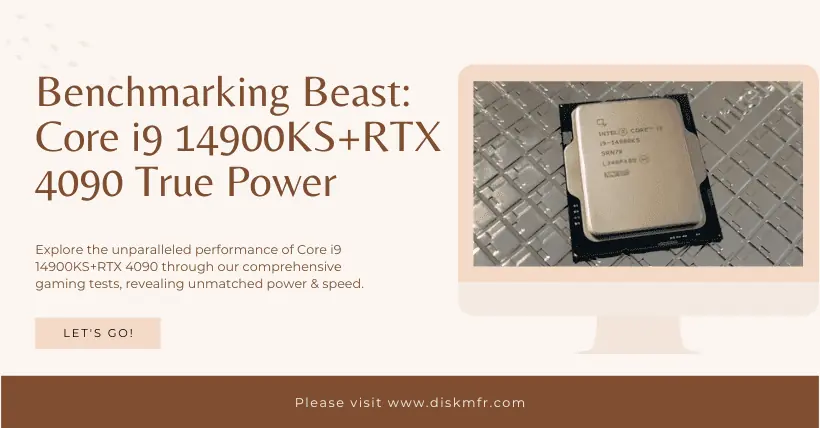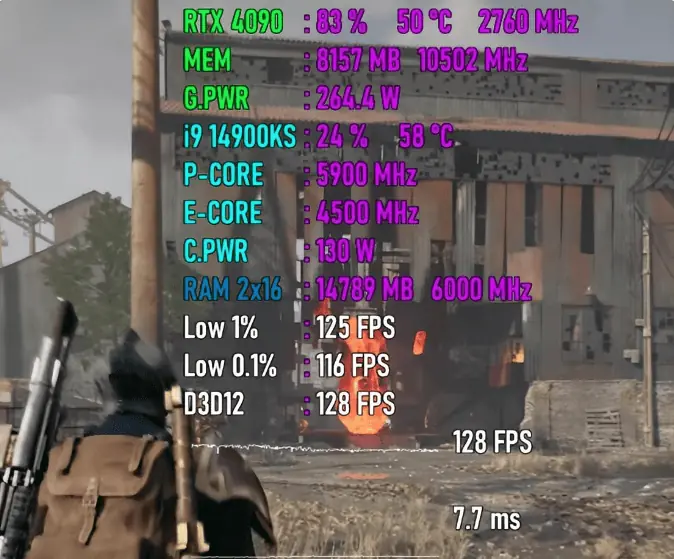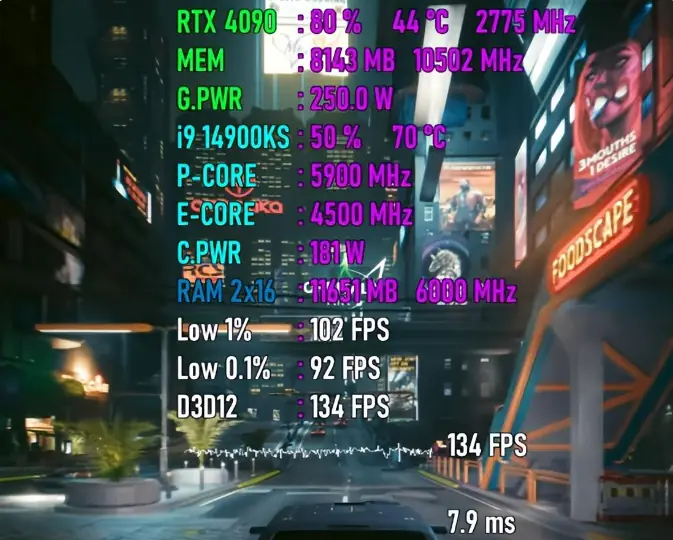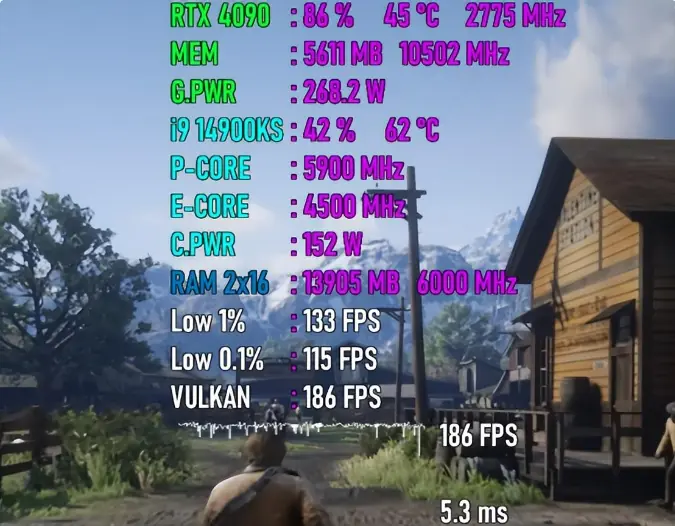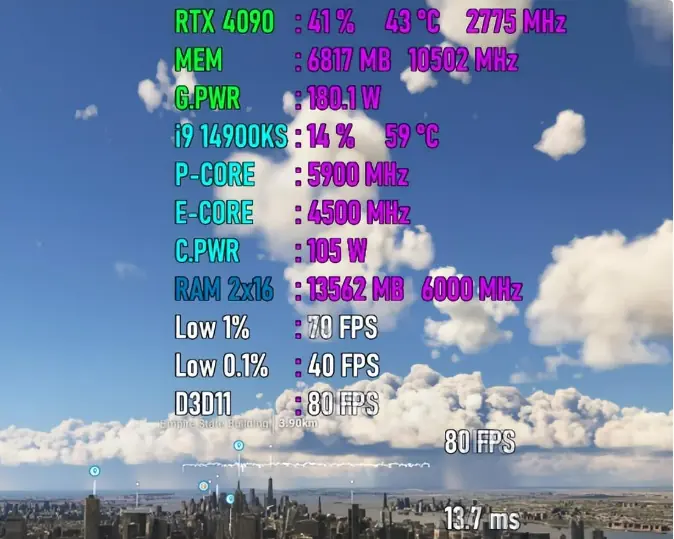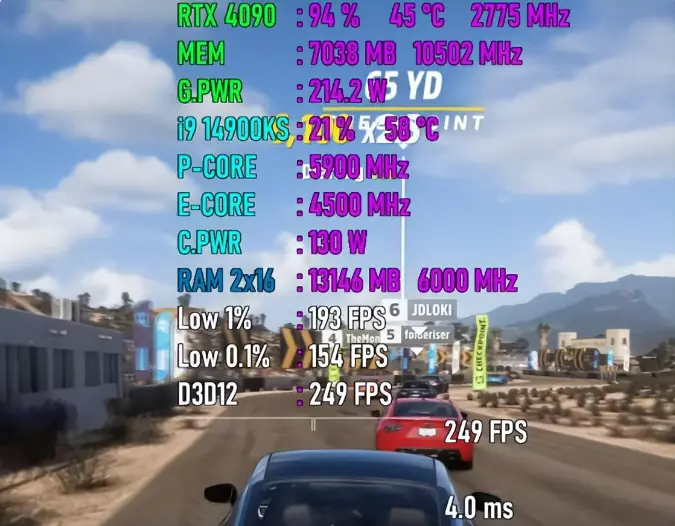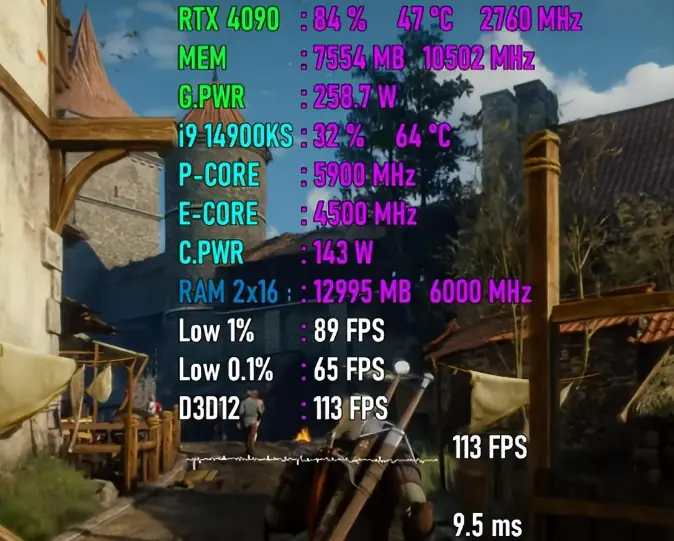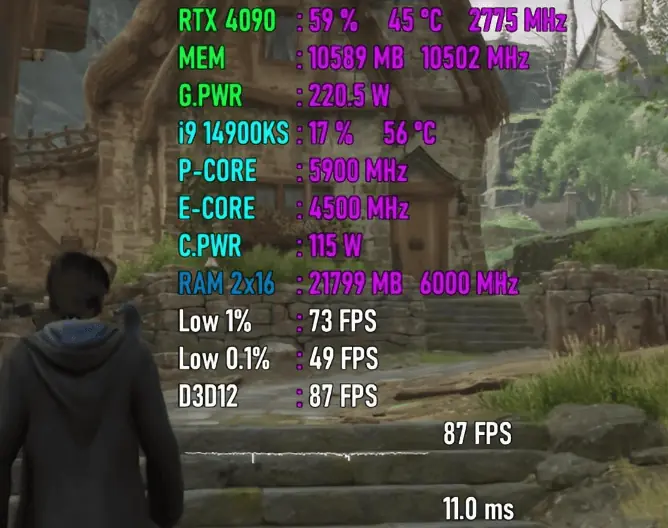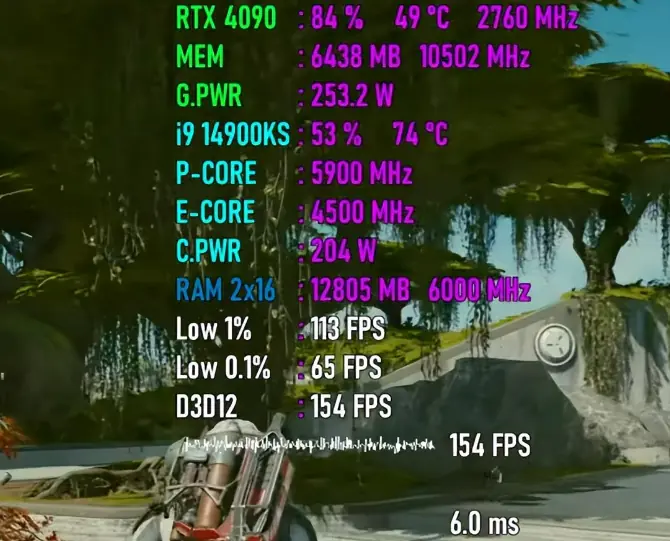March 14, Intel officially released the Core i9-14900KS, the biggest selling point of this processor is the maximum operating frequency can reach 6.2 GHz.
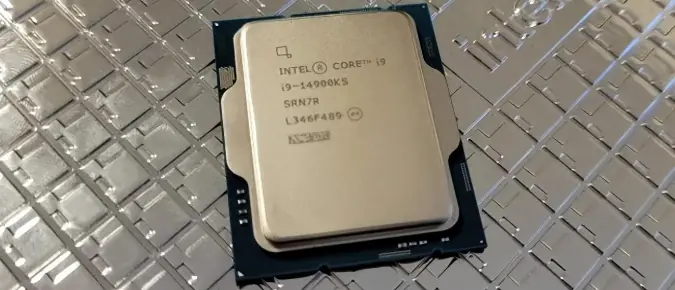
Of course, this processor also has a huge overclocking space, 6.2 GHz is certainly not the upper limit of the Core i9-14900KS maximum operating frequency, according to my understanding, there are already geeks over 9GHz. (Core i9 14900KS vs Ryzen 9 7950X3D: Ultimate Showdown!)
The topic of this article is not to share the overclocking performance of Core i9-14900KS, but to share the game performance test, many friends are very interested in the actual performance of this processor in the end how strong, this article will reveal the answer.
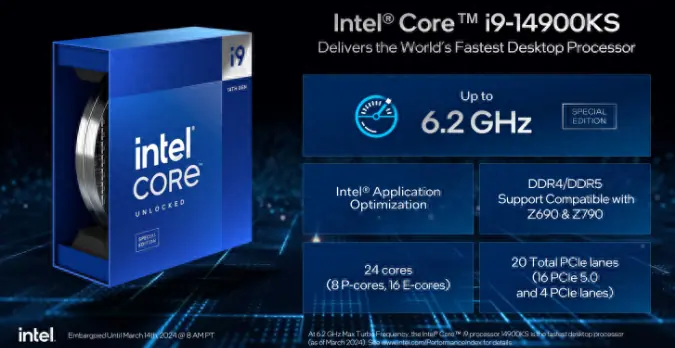
Since the processor has been chosen Core i9-14900KS, there is no reason why the graphics card should not be pulled full of GeForce RTX 4090, therefore, in this article, we will choose Core i9-14900KS+GeForce RTX 4090, a top-notch dream combination configuration, to satisfy everyone’s curiosity.
01
Parameter introduction (Core i9 14900KS+RTX 4090)
Released on March 14th, the Core i9-14900KS is built on a 10nm process with 8 large cores and 16 small cores for a total of 24 cores and 32 threads, carrying 32MB of L2 cache and 36MB of L3 cache.
It runs at 3.2 GHz standard and 6.2 GHz maximum, consumes 150W standard and 320W maximum, and has a suggested retail price of $689.

02
The test platform configuration (Core i9 14900KS+RTX 4090)
The main configuration is as follows:
Core i9-14900KS processor, ASUS OG Strix Z790-E Gaming motherboard, 32GB DDR5 6000MHz RAM, GeForce RTX 4090 graphics card, two Samsung 970 hard disks, and Windows 11 operating system.
03
Game Testing (Core i9 14900KS+RTX 4090)
The following will test eight games individually, all using 1080P highest quality mode.
The first game is “Relic 2”.
- Average Frame Rate: 128 FPS
- Lowest Momentary Frame: 125 FPS
- Frame Time: 7.7ms
- CPU usage: 24%
- CPU Power Consumption: 130W
- CPU temperature: 58 degrees
- Memory usage: 14.8GB
- GPU usage: 83%
- VRAM usage: 8.2GB
- GPU Power Consumption: 264W
- GPU temperature: 50 degrees
In this game, the CPU usage is only about a quarter, and the GPU usage is slightly over 80%, which is high, but there is still some surplus. Memory usage is close to 15GB, and video memory usage has exceeded 8GB, surpassing the upper limit of entry-level graphics card memory, such as GeForce RTX 4060 and Radeon RX 7600.
In terms of average frame rate, it can easily run above 120 FPS, and the minimum instantaneous frame rate is also very close, with little fluctuation in frame rate, very stable, and the frame time is around 8ms.
The second game is “Cyberpunk 2077”.
- Average Frame Rate: 134 FPS
- Lowest Momentary Frame: 102 FPS
- Frame Time: 7.9ms
- CPU usage: 50%
- CPU Power Consumption: 181W
- CPU temperature: 70 degrees
- Memory usage: 11.7GB
- GPU usage: 80%
- VRAM usage: 8.1GB
- GPU Power Consumption: 250W
- GPU temperature: 44 degrees
In this game, the CPU usage reaches 50%, nearly double that of the previous game, the GPU usage is close to 80%, similar to the previous game, and the memory usage is under 12GB, with video memory usage also exceeding 8GB.
In terms of average frame rate, it can run above 130 FPS, the minimum instantaneous frame rate is above 100 FPS, and the frame time is also around 8ms.
The third game is “Red Dead Redemption 2”.
- Average Frame Rate: 186 FPS
- Lowest Momentary Frame: 133 FPS
- Frame Time: 5.3ms
- CPU usage: 42%
- CPU Power Consumption: 152W
- CPU temperature: 62 degrees
- Memory usage: 13.9GB
- GPU usage: 86%
- VRAM usage: 5.6GB
- GPU Power Consumption: 268W
- GPU temperature: 45 degrees
In this game, the CPU usage is 42%, between the first two games, the GPU usage is 86%, higher than the first two, and the video memory usage is under 6GB.
In terms of average frame rate, it can run above 180 FPS, the minimum instantaneous frame rate is above 130 FPS, and the frame time is around 5ms, overall outperforming the first two games.
The fourth game is “Microsoft Flight Simulator”.
- Average Frame Rate: 80 FPS
- Lowest Momentary Frame: 70 FPS
- Frame Time: 13.7ms
- CPU usage: 14%
- CPU Power Consumption: 105W
- CPU temperature: 59 degrees
- Memory usage: 13.6GB
- GPU usage: 41%
- VRAM usage: 6.8GB
- GPU Power Consumption: 180W
- GPU temperature: 43 degrees
In this game, the CPU usage is only 14%, and the GPU usage is only 41%, the memory usage is under 14GB, and the video memory usage is under 7GB, relatively lighter compared to the previous games.
In terms of average frame rate, it can run around 80 FPS, the minimum instantaneous frame rate is around 70 FPS, and the frame time is around 14ms, slightly worse compared to the previous games.
The fifth game is “Forza Horizon 5”.
- Average Frame Rate: 349 FPS
- Lowest Momentary Frame: 193 FPS
- Frame Time: 4.0ms
- CPU usage: 21%
- CPU Power Consumption: 130W
- CPU temperature: 58 degrees
- Memory usage: 13.1GB
- GPU usage: 94%
- VRAM usage: 7.0GB
- GPU Power Consumption: 214W
- GPU temperature: 45 degrees
In this game, the CPU usage is about one-fifth, the GPU usage reaches 94%, the highest among all games, memory usage is over 13GB, and video memory usage is around 7GB.
In terms of average frame rate, it can run above 240 FPS, the minimum instantaneous frame rate is above 190 FPS, and the frame time is around 4ms, overall very smooth.
The sixth game is “The Witcher 3”.
- Average Frame Rate: 113 FPS
- Lowest Momentary Frame: 89 FPS
- Frame Time: 9.5ms
- CPU usage: 32%
- CPU Power Consumption: 143W
- CPU temperature: 64 degrees
- Memory usage: 13.0GB
- GPU usage: 84%
- VRAM usage: 7.6GB
- GPU Power Consumption: 259W
- GPU temperature: 47 degrees
In this game, the CPU usage is a bit over 30%, the GPU usage is 84%, also relatively high, memory usage is around 13GB, and video memory usage is under 8GB.
In terms of average frame rate, it can run above 110 FPS, the minimum instantaneous frame rate is above 80 FPS, and the frame time is below 10ms.
The seventh game is “Hogwarts Legacy”.
- Average Frame Rate: 87 FPS
- Lowest Momentary Frame: 73 FPS
- Frame Time: 11.0ms
- CPU usage: 17%
- CPU Power Consumption: 115W
- CPU temperature: 56 degrees
- Memory usage: 21.8GB
- GPU usage: 59%
- VRAM usage: 10.6GB
- GPU Power Consumption: 221W
- GPU temperature: 45 degrees
In this game, the CPU usage is only 17%, the GPU usage is nearly 60%, memory usage is nearly 22GB, and the significant video memory consumption is a characteristic of this game, with video memory usage close to 11GB, also quite high.
In terms of average frame rate, it can run above 80 FPS, the minimum instantaneous frame rate is above 70 FPS, and the frame time is around 11ms.
The eighth game is “Starfield”.
- Average Frame Rate: 154 FPS
- Lowest Momentary Frame: 113 FPS
- Frame Time: 6.0ms
- CPU usage: 53%
- CPU Power Consumption: 204W
- CPU temperature: 74 degrees
- Memory usage: 12.8GB
- GPU usage: 84%
- VRAM usage: 6.4GB
- GPU Power Consumption: 253W
- GPU temperature: 49 degrees
In this game, the CPU usage is over 50%, the highest among all tested games, the GPU usage is also 84%, close to the data of many previous games, memory usage is close to 13GB, and video memory usage is over 6GB.
In terms of average frame rate, it can run above 150 FPS, the minimum instantaneous frame rate is above 110 FPS, and the frame time is around 6ms.
For this game, this is the best performance seen by the author so far. As a reference, the recently popular Ryzen 7 8700G can only just manage an average frame rate of just over 30 FPS.
04
Pros and Cons of i9 14900KS
✅Advantages: It’s almost the fastest CPU
We like the Ryzen 7 7800X3D. It’s the best gaming CPU—even though the 14900K and KS are sometimes very competitive—thanks to its incredible performance, relatively moderate price tag, and astonishing efficiency. But it’s undeniable that the 14900KS is a faster all-around CPU. It’s very close in games, often winning by less than a 1% margin at 4K resolution, and trailing by an average of about 5% at 1080p resolution. As TomsHardware said: “In any case, most people buying a $689 chip will be gaming at higher resolutions than 1080p, and the difference between the original and KS models at 1440p is still only 2.5%.”
But where the 14900KS truly shines is in productivity. Like its predecessor, the 14900K, its plethora of cores (24 cores, supporting 32 threads) means it can do more things at once compared to AMD’s offerings. The AMD 7950X, with its 16 high-performance Zen 4 cores, offers reasonable competition, but it lacks the gaming prowess of the X3D models, thus falling behind Intel’s alternative.
The high clock speeds of the 14900KS come into play in applications that benefit from single-core performance. In tests by HotHardware, it found that when running single-threaded or light-threaded workloads, the HEDT platform falls behind the Core i9-14900KS. Although the Threadripper and its ilk will run circles around these types of CPUs in video transcoding or encryption, the 14900KS excels in applications like Premiere and Photoshop.
It also broke some records, perhaps most notably achieving the highest clock speed ever. According to Videocardz, Swedish overclocker Elmor managed to push their 14900KS to 9117.75MHz—which is about 70MHz higher than the previous record set in October last year with the 14900KF. Asus also set records with its 14900KS samples in PiFast, SuperPi 1M, and PyPrime 32B.
✅Disadvantages: It uses up all the power
If you think the 14900K is a power hog, wait until you see the 14900KS. While its base Thermal Design Power (TDP) is only 25 watts higher than the 14900K, its maximum turbo power rating is still 253W, but under the right circumstances, it can consume more power than any other processor.
“The 14900KS is configured with a power limit setting of 320W, which it can easily hit when loaded with applications that can scale to all cores,” says W1zzard from TechPowerUp. “On average, we measured application power consumption at 208 W, which is the highest we’ve ever recorded, 30W higher than the 14900K. With the 320W power limit removed, average application power reached 232W, with Blender setting a record at 508W.”
Just the CPU consuming 500W is astonishing, although this isn’t something you’d experience in gaming—it typically averages around 160W there—but it’s not practical for most users. It’s more than any other processor and over three times that of our favorite gaming CPU, the 7800X3D.
This leads to temperature issues. TechPowerup tested it with a high-end Noctua NH-U14S air cooler, and during multi-threaded tests, the 14900KS reached 118 degrees Celsius, nearing 100 degrees in gaming. Overclock3D could only stop it from thermal throttling by delidding it—essentially removing the internal heat spreader, taking a significant risk of damaging the CPU in the process.
Even with undervolting and a 360mm AIO, the load temperatures still reached 86 degrees.
05
Test Conclusion
Overall, the Core i9-14900KS+GeForce RTX 4090 setup ran 1080P games very easily, with little fluctuation between the average frame rate and the lowest instantaneous frame rate, except for the high average frame rate and low frame time, which were very stable.
In all game tests, the Core i9-14900KS has a maximum CPU utilization of only 53% and the GeForce RTX 4090 has a maximum GPU utilization of only 94%, which is a very low load in most of the game tests, and still some of the performance is not utilized.
Therefore, the above test results are very conservative and do not reflect the highest actual gaming performance of the Core i9-14900KS+GeForce RTX 4090 setup, but can only be roughly used as a reference.
Of course, there must be a lot of friends here who still do not feel addicted, but also want to see the test in 4K image quality mode, the comparison test with competitors, etc., – No Problem, this article is just an appetizer, everything is in the arrangement, so stay tuned.
Related:
- Core i7 11700K vs i7 14700K: Performance Gap Unveiled!
- ASUS RTX 4090D: Overclock to Match RTX 4090 Level!

Disclaimer:
- This channel does not make any representations or warranties regarding the availability, accuracy, timeliness, effectiveness, or completeness of any information posted. It hereby disclaims any liability or consequences arising from the use of the information.
- This channel is non-commercial and non-profit. The re-posted content does not signify endorsement of its views or responsibility for its authenticity. It does not intend to constitute any other guidance. This channel is not liable for any inaccuracies or errors in the re-posted or published information, directly or indirectly.
- Some data, materials, text, images, etc., used in this channel are sourced from the internet, and all reposts are duly credited to their sources. If you discover any work that infringes on your intellectual property rights or personal legal interests, please contact us, and we will promptly modify or remove it.

